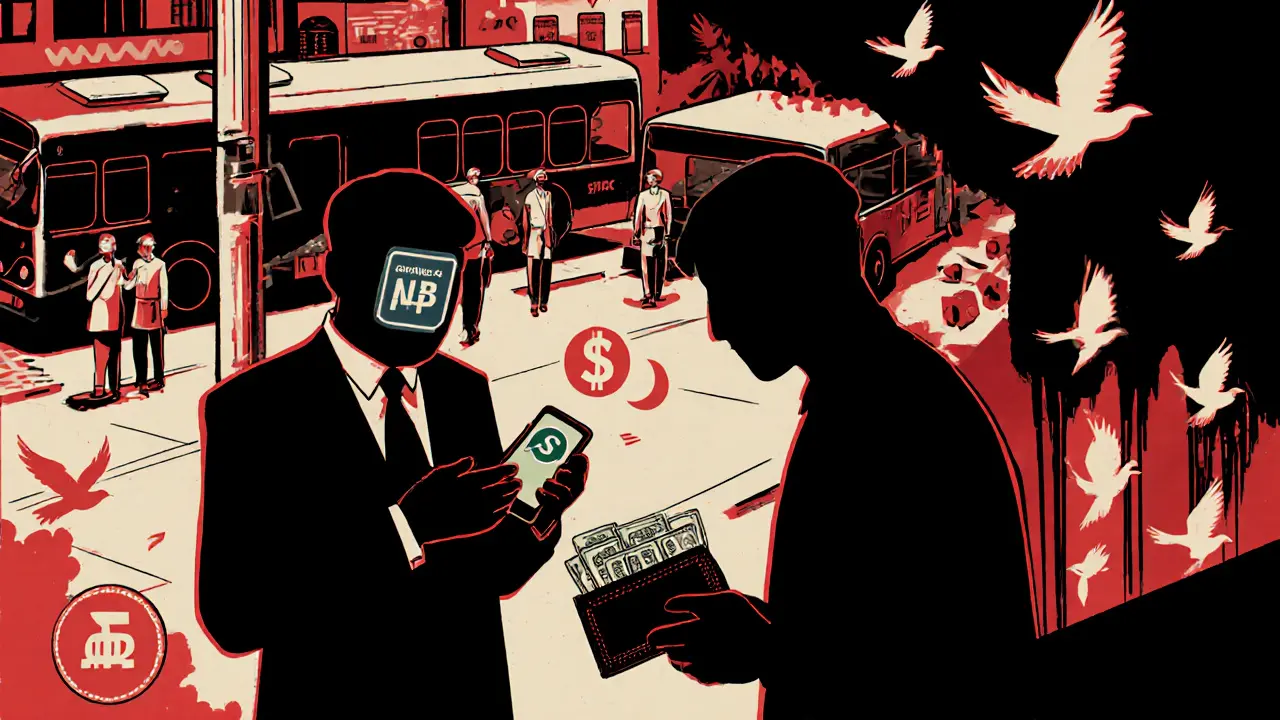Remittance Cost Calculator: Crypto vs Traditional
Calculate how much you save by using cryptocurrency for remittances instead of traditional services. Based on Nepal's remittance landscape where traditional services charge 5-10% fees while crypto costs around 2%.
On paper, cryptocurrency is illegal in Nepal. The Nepal Rastra Bank (NRB) banned all crypto trading, mining, and payments in 2021. Anyone caught using Bitcoin, Ethereum, or any other digital coin risks up to three years in jail, fines up to three times the transaction value, and seizure of their devices or wallets. Yet, every day, thousands of Nepalis are quietly sending and receiving crypto across borders - not for speculation, but to survive.
Why Crypto? Because the Banks Won’t Help
Nearly 30% of Nepal’s economy runs on remittances. Every year, over $8 billion flows in from Nepalis working abroad - mostly in India, Malaysia, Qatar, and the Gulf. These are not wealthy professionals. They’re construction workers, nurses, drivers, and domestic helpers. They send money home to feed families, pay school fees, or fix roofs. Traditional remittance services like Western Union or MoneyGram charge 5-10% in fees. That’s $400-$800 lost on every $8,000 sent. Processing takes 2-5 days. Sometimes, banks in Gulf countries freeze accounts if they suspect the sender is a migrant worker. And in Nepal, rural branches often don’t have the cash to pay out large sums. So people wait. Sometimes for days. Crypto cuts that down to minutes. A worker in Dubai sends 500 AED worth of USDT (Tether) via a peer-to-peer app. Their cousin in Pokhara receives it in a WhatsApp group, swaps it for NPR through a local trader, and withdraws cash from a nearby shop. No bank. No paperwork. No waiting.The Underground Network
There’s no official data on how many Nepalis use crypto. No government report tracks it. But ask around Kathmandu’s tech cafes or college campuses, and you’ll hear the same story: crypto is the silent backup system. It’s not done on exchanges like Binance or Coinbase - those are blocked in Nepal. Instead, people use decentralized tools:- Telegram groups with local crypto traders who buy and sell USDT for NPR
- WhatsApp communities where people post wallet addresses and payment screenshots
- P2P platforms like LocalBitcoins or Paxful, accessed through VPNs
- Friends who travel to India or Dubai and carry crypto wallets as digital cash

The Government’s Blind Spot
The NRB says crypto fuels money laundering and Ponzi schemes. And yes - scams exist. A fake “NepalCoin” project stole millions in 2022. But blaming all crypto for the crimes of a few is like banning cars because someone drove drunk. The real issue? Nepal’s financial system is broken. Most people can’t open bank accounts without a permanent address. Rural areas have no ATMs. Mobile banking apps require internet and ID verification - both unreliable for migrant workers. Meanwhile, the government is pushing its own digital currency, a CBDC, expected to launch in 2027. But that’s four years away. And it won’t solve the core problem: people need fast, cheap, borderless money now.How They Avoid Getting Caught
Nepalis aren’t dumb. They know the law. So they adapt.- They use cash-only trades. No bank transfers. No digital trail.
- They meet in public places - cafes, bus stations, temples - to swap crypto for cash.
- They rotate wallets. One for incoming remittances. One for spending. One for backup.
- They use burner phones. One for crypto. One for calls. Never linked.
- They avoid large transactions. Under 50,000 NPR (about $370) is less likely to trigger suspicion.

The Human Cost of the Ban
The ban doesn’t stop crypto. It just makes it dangerous. People lose money to scammers because there’s no legal recourse. A trader in Lalitpur vanished with 12 million NPR in 2023. No police case was opened - because the victim was using crypto. No protection. No insurance. No recourse. Teenagers download crypto apps and get tricked into sending funds to fake “investment schemes.” Families are torn apart when someone gets arrested. In 2024, a 19-year-old in Dharan was jailed for six months after police found a crypto wallet on his phone. He had been helping his sister pay for medical treatment in India. The government calls this enforcement. Those on the ground call it cruelty.What’s Next?
The ban isn’t sustainable. It’s like trying to stop water with a sieve. Young Nepalis are more connected than ever. They watch YouTube tutorials on blockchain. They know how wallets work. They’ve seen how crypto lifts people out of poverty in Nigeria, Vietnam, and the Philippines. They’re not asking for permission. They’re building their own system - quietly, carefully, illegally. The government’s CBDC might look like a solution. But if it’s slow, centralized, and tied to ID systems that exclude the poor, it won’t replace crypto. It’ll just add another layer of bureaucracy. Until then, the underground network will keep growing. And it won’t be stopped by laws. It’ll be stopped only when Nepal finally admits: the people aren’t breaking the rules. The rules are broken.Is cryptocurrency completely illegal in Nepal?
Yes. As of 2025, Nepal Rastra Bank (NRB) maintains a complete ban on all cryptocurrency activities - including trading, mining, sending, receiving, and using crypto for payments. This is enforced under the Foreign Exchange Regulation Act (2019). Violations can lead to imprisonment of up to three years, fines up to three times the transaction value, and seizure of digital devices or wallets.
Why do Nepalis still use crypto if it’s banned?
Most Nepalis use crypto for cross-border remittances. Traditional services like Western Union charge 5-10% in fees and take days to process. Crypto transfers take minutes and cost under 2%. For families relying on money sent from abroad, crypto is often the only affordable, fast option - even if it’s illegal.
How do Nepalis avoid getting caught using crypto?
They use cash-only peer-to-peer trades, meet in public places, rotate wallets, and avoid large transactions. Many use burner phones and VPNs to access apps. Transactions are kept under 50,000 NPR to reduce suspicion. No bank accounts or digital trails are used. Most trades happen through WhatsApp or Telegram groups.
What are the risks of using crypto in Nepal?
The biggest risks are fraud, theft, and no legal protection. If you’re scammed, you can’t report it to police without admitting you broke the law. Wallets can be hacked. Traders can disappear. Arrests happen - especially in cities like Kathmandu and Birgunj. There’s no insurance, no recourse, and no way to recover lost funds.
Is Nepal planning to legalize cryptocurrency?
No. Nepal’s government is moving toward a central bank digital currency (CBDC), expected to launch around 2027. But this is not cryptocurrency - it’s a government-controlled digital rupee. The NRB has made it clear that Bitcoin, Ethereum, and other decentralized coins will remain banned. The goal is to replace crypto with a state-run system, not regulate it.
Who is most affected by Nepal’s crypto ban?
Migrant workers and their families depend on remittances. Young, tech-savvy Nepalis who want to use blockchain for innovation are also impacted. They’re caught between global trends and a rigid legal system. Many avoid crypto entirely out of fear. Others risk jail because they have no other choice.



